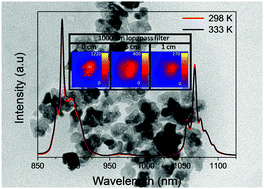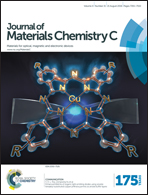Luminescence thermometry and imaging in the second biological window at high penetration depth with Nd:KGd(WO4)2 nanoparticles†
Abstract
Neodymium-doped monoclinic KGd(WO4)2 nanoparticles were synthesized by the Pechini sol–gel method. Under excitation at 808 nm, the 3 at% Nd:KGd(WO4)2 nanoparticles exhibited strong emission bands at 883 nm and 1067 nm in the near infrared region range, corresponding to the 4F3/2 → 4I9/2 and 4F3/2 → 4I11/2 transitions of Nd3+, and lying in the first and second biological windows, respectively. Both emissions show promising properties for thermal sensing in this range of wavelengths. In fact, the thermal analysis of these nanoparticles indicated a linear ascent behavior of the fluorescence intensity ratio. The surface of these nanoparticles was functionalized by silanization using 3-aminopropyltriethoxysilane as the coupling agent, allowing deagglomeration with particle sizes around 16 nm, which allowed dispersing them in water. In this form they were used for NIR imaging in the second biological window, achieving a penetration depth of 1 cm. Hence these nanoparticles are promising for nanothermometry and imaging applications in the second biological window.

- This article is part of the themed collection: 2016 Journal of Materials Chemistry C Hot Papers


 Please wait while we load your content...
Please wait while we load your content...